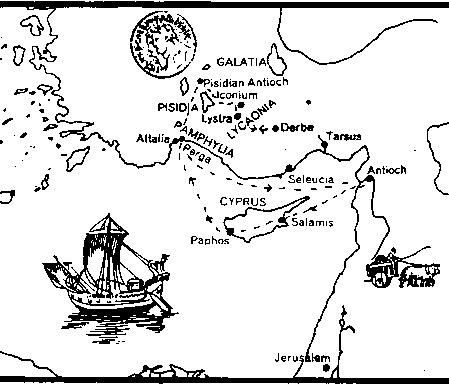
Index/Table of Contents
Old Testament
and New Testament
Credits and Copyright
ACTS
LECTURE 22
THE FIRST MISSIONARY JOURNEY
Content of Lecture
(The following is a continuation of the outline of Acts:)
Part II The Christian Mission to the Gentile World (12:25-28:31)
IV. The First Missionary Journey and the Jerusalem Council (12:25-15:35)
A. The Missionaries sent out (12:25-13:3) (TN1)
B. The Mission on Cyprus and John Mark's Departure (13:4-13) (TN2)Since Barnabas was a native of Cyprus, the initial focus of this journey included an effort to reach his countrymen.
C. The Work at Antioch of Pisidia (13:14-52)
1. A Welcome Extended (13:14-15)
Paul's missionary strategy (1) started with the large cities of the region, (2) then moved to a place where an informed or prepared audience could be found (the Synagogue) and (3) focused on those who would respond (eventually he found the Gentiles to be more receptive than most Jews).
2. Paul's Synagogue Sermon at Antioch (13:16-41)
Although Paul had preached often, this is the first sermon recorded in any detail. Note the emphasis on Christ's fulillment of prophecy and resurrection (13:32-39)
3. Varying Responses to the Sermon (13:42-45)
4. To the dews First, but also to the Gentiles (13:46-52)D. The Work in South Galatia (14:1-28) (TN3)
1. The Work at Iconium (14:1-7)
2. The Work at Lystra (14 8_20)
3. The Work at Derbe and return to Antioch (14:21-28)E. The Jerusalem or apostolic Council (15:1-35)
1. The Delegation from Syrian Antioch (15:1-4)
2. The Nature and Course of the Debate (15:5-12)
3. The Summing Up by James (15:13-21)The presiding official is "the Lord's brother" or "James the Just," the traditional author of the Epistle of James. The decision of the council emphasized liberty and integrity. While the Gentiles were bee of the legalistic requirements of the law (liberty) that freedom was not to be misconstrued as license to sin.
4. The Decision and Letter of the Council (15:22-29)
5. The Reception of the Council's Decision (15:30-35)
Assignment
Read Galatians and determine why Paul felt the necessity
to write what he did.
What is Paul's understanding of how a person becomes a Christian?
What is the purpose of the law? What was Paul feeling as he wrote this letter?
Alternate assignment
If you choose to cover Paul's letters after you have covered the Book of Acts, ask students to read Acts 15:36-18:23, and identify the major events which took place on the second missionary journey.
MAP
From Introducing the New Testament John Drane,
Harper and Row, San Fran., 1986, p. 281

| TEACHER'S NOTES TN A map of the First Missionary Journey will help students identify the major places visited, including Cyprus, Perga, Antioch of Pisidia, Iconium, Lystra and Derbe. (Note map at the end of this lecture.) TN The following comments and questions could initiate the study of this section of Acts: Beginning with this part of Acts,, a series of three missionary campaigns are described. Leaders such as Paul and Barnabas earned the Christian message to various cities in the Mediterranean. world. Why were the early Christians so evangelistic? Do you think it was appropriate for Christians to use the Jewish house of worship (the Synagogue) as the setting for communicating their message? Among the most receptive to the Christian presentation were non-Jews or Gentiles. Can you think of reasons the Christian Gospel would have attracted the Gentile seekers? TN1 This seems to be the first organized effort to spread the Gospel. Most of the earlier work resulted from the persecution of Stephen which forced many Christians to leave Jerusalem. The listing of Barnabas before Paul (13:2) may indicate that Barnabas was more respected by the church and initially given the dominant role. TN2 John Mark was probably a relative of Barnabas. Why might he have become disillusioned with what was happening? Many students will identify with his desire to go home. TN3 The Roman province of Galatia may not have included the cities of Iconium, Lystra, and Derbe, leading certain scholars to believe that Paul's Letter to the Galatians was written to unnamed churches further north (North Galatian Theory). The South Galatian Theory suggests that Iconium, Lystra and Derbe are being addressed, allowing- Galatians to be among Paul's earliest letters. |
| DISCUSSION QUESTIONS DQ Does a Christian have to observe the JewishDQ What is required in order to be a Chrisdan or how does one become a Christian? DQ What is the relationship between faith and works? DQ What is the relationship between the Old and New Testaments? DQ What were the issues of the Jerusalem Council? DQ Is it surprising to you that not everyone in the early church agreed on what was required to be a Christian? DQ How did the Jerusalem Council relate to the work of Paul and Barnabas on the First Missionary Journey? DQ Which of the issues of the Jerusalem Council are still being discussed in Christian circles? What would the contemporary Christian church say are the essentials of becoming a Christian? In your opinion, does Christianity surer more from legalism or license? Where do you see vestiges of legalism and license in contemporary Christianity? |
Credits and Copyright This online text book is provided by the Division of Student Ministry of the Baptist General Convention of Texas, 333 N. Washington Dallas, Texas 75246-1798 214.828.5100 Use the text to meet your academic needs. If you copy any part of this online text, please give credit to the Division of Student Ministry of the Baptist General Convention of Texas. Any donations which you give will be used in the Division of Student Ministry Summer Missions Programs.